Swash-Zone Formula Evaluation of Morphological Variation in Haeundae Beach, Korea
Abstract
1. Introduction
2. Model Description
2.1. Flow Module
2.2. Wave Module
2.3. Sediment Transport Module
2.3.1. Sediment Transport in Swash Zone
2.3.2. Bedload
2.3.3. Suspended Load
2.3.4. Morphological Changes
3. Experiment
3.1. Field Observation
3.2. Numerical Model Setup
4. Results
4.1. Model Validation
4.2. Morphological Changes—Test Case with Imaginary Breakwater
4.3. Morphological Change without LW07
4.4. Morphological Changes with LW07
5. Discussion
6. Conclusions
Author Contributions
Funding
Data Availability Statement
Conflicts of Interest
References
- Pelnard-Considère, R. Essai de theorie de l’evolution des formes de rivage en plages de sable et de galets. Journées De L’hydraulique 1957, 4, 289–298. [Google Scholar]
- Ruggiero, P.; Buijsman, M.; Kaminsky, G.M.; Gelfenbaum, G. Modeling the effects of wave climate and sediment supply variability on large-scale shoreline change. Mar. Geol. 2010, 273, 127–140. [Google Scholar] [CrossRef]
- Chang, Y.S.; Huisman, B.; De Boer, W.; Yoo, J. Hindcast of Long-term Shoreline Change due to Coastal Interventions at Namhangjin, Korea. J. Coast. Res. 2018, 85, 201–205. [Google Scholar] [CrossRef]
- Drønen, N.; Deigaard, R. Quasi-three-dimensional modelling of the morphology of longshore bars. Coast. Eng. 2007, 54, 197–215. [Google Scholar] [CrossRef]
- Militello, A.; Reed, C.W.; Zundel, A.K.; Kraus, N.C. Two-Dimensional Depth-Averaged Circulation Model M2D: Version 2.0, Report 1, Technical Documentation and User’s Guide; U.S. Army Engineer Research and Development Center: Vicksburg, MS, USA; Washington, DC, USA, 2004. [Google Scholar]
- Buttolph, A.M.; Kraus, N.C.; Wamsley, T.V. Two-Dimensional Depth-Averaged Circulation Model CMS-M2D: Version 3.0. Sediment Transport and Morphology Change. Report 2; U.S. Army Engineer Research and Development Center: Vicksburg, MS, USA; Washington, DC, USA, 2006. [Google Scholar]
- Bruneau, N.; Bonneton, P.; Pedreros, R.; Dumas, F.; Idier, D. A new morphodynamic modelling platform: Application to characteristic sandy systems of the Aquitanian Coast, France. J. Coast. Res. 2007, 50, 932–936. Available online: https://www.jstor.org/stable/26481716 (accessed on 10 March 2024).
- Roelvink, D.; Reniers, A.; Van Dongeren, A.; De Vries, J.V.T.; McCall, R.; Lescinski, J. Modelling storm impacts on beaches, dunes and barrier islands. Coast. Eng. 2009, 56, 1133–1152. [Google Scholar] [CrossRef]
- Nam, P.T.; Larson, M.; Hanson, H. A numerical model of nearshore waves, currents, and sediment transport. Coast. Eng. 2009, 56, 1084–1096. [Google Scholar] [CrossRef]
- Nam, P.T.; Larson, M.; Hanson, H. Modeling morphological evolution in the vicinity of coastal structures. In Proceedings of the ASCE 32nd International Conference on Coastal Engineering, Shanghai, China, 6 February 2011. [Google Scholar]
- Nam, P.T.; Larson, M. Model of nearshore waves and wave-induced currents around a detached breakwater. J. Waterw. Port Coast. Ocean Eng. 2010, 136, 156–176. [Google Scholar] [CrossRef][Green Version]
- Nam, P.T.; Larson, M.; Hanson, H. A numerical model of beach morphological evolution due to waves and currents in the vicinity of coastal structures. Coast. Eng. 2011, 58, 863–876. [Google Scholar] [CrossRef]
- Baykal, C.; Ergin, A.; Güler, I. Two-dimensional depth-averaged beach evolution modeling: Case study of the Kızılırmak River mouth, Turkey. J. Waterw. Port Coast. Ocean Eng. 2014, 140, 05014001. [Google Scholar] [CrossRef]
- Karambas, T.V.; Samaras, A.G. An integrated numerical model for the design of coastal protection structures. J. Mar. Sci. Eng. 2017, 5, 50. [Google Scholar] [CrossRef]
- Hermawan, S.; Bangguna, D.; Mihardja, E.; Fernaldi, J.; Prajogo, J.E. The hydrodynamic model application for future coastal zone development in remote area. Civ. Eng. J. 2023, 9, 1828–1850. [Google Scholar] [CrossRef]
- Chen, W.; Van Der Werf, J.; Hulscher, S. A review of practical models of sand transport in the swash zone. Earth Sci. Rev. 2023, 238, 104355. [Google Scholar] [CrossRef]
- Larson, M.; Wamsley, T.V. A formula for longshore sediment transport in the swash. In Coastal Sediments’ 07; American Society of Civil Engineers (ASCE): New Orleans, LA, USA, 2007; pp. 1924–1937. [Google Scholar]
- Villaret, C.; Hervouet, J.-M.; Kopmann, R.; Merkel, U.; Davies, A.G. Morphodynamic modeling using the Telemac finite-element system. Comput. Geosci. 2013, 53, 105–113. [Google Scholar] [CrossRef]
- Larson, M.; Kubota, S.; Erikson, L. Swash-zone sediment transport and foreshore evolution: Field experiments and mathematical modeling. Mar. Geol. 2004, 212, 61–79. [Google Scholar] [CrossRef]
- Madsen, O. Sediment Transport on the Shelf, in ‘Sediment Transport Workshop Proc; DRP TA1; CERC: Vicksburg, MI, USA, 1993. [Google Scholar]
- Hervouet, J.M. A high resolution 2-D dam-break model using parallelization. Hydrol. Process. 2000, 14, 2211–2230. [Google Scholar] [CrossRef]
- Hervouet, J.-M. Hydrodynamics of Free Surface Flows: Modelling with the Finite Element Method; John Wiley & Sons: Hoboken, NJ, USA, 2007. [Google Scholar]
- Do, J.D.; Jin, J.-Y.; Hyun, S.K.; Jeong, W.M.; Chang, Y.S. Numerical investigation of the effect of wave diffraction on beach erosion/accretion at the Gangneung Harbor, Korea. J. Hydro-Environ. Res. 2020, 29, 31–44. [Google Scholar] [CrossRef]
- Do, J.-D.; Hyun, S.-K.; Jin, J.-Y.; Lee, B.; Jeong, W.-M.; Ryu, K.-H.; Back, W.-D.; Choi, J.-H.; Chang, Y.S. Wave Transformation behind a Breakwater in Jukbyeon Port, Korea—A Comparison of TOMAWAC and ARTEMIS of the TELEMAC System. J. Mar. Sci. Eng. 2022, 10, 2032. [Google Scholar] [CrossRef]
- EDF-R&D. TELEMAC Modelling System. 2D Hydrodynamics TELEMAC-2D Software Release 7.0 USER MANUAL; EDF R&D: Orvanne, France, 2014. [Google Scholar]
- EDF-R&D. Sisyphe v6.3 User’s Manual; EDF R&D: Orvanne, France, 2014. [Google Scholar]
- EDF-R&D. TELEMAC Modelling System. TOMAWAC Software. Release 7.1 OPERATING MANUAL; EDF R&D: Orvanne, France, 2016. [Google Scholar]
- Asaro, G.; Paris, E. The effects induced by a new embankment at the confluence between two rivers: TELEMAC results compared with a physical model. Hydrol. Process. 2000, 14, 2345–2353. [Google Scholar] [CrossRef]
- Giardino, A.; Ibrahim, E.; Adam, S.; Toorman, E.A.; Monbaliu, J. Hydrodynamics and cohesive sediment transport in the Ijzer estuary, Belgium: Case study. J. Waterw. Port Coast. Ocean Eng. 2009, 135, 176–184. [Google Scholar] [CrossRef]
- Robins, P.E.; Davies, A.G. Application of TELEMAC-2D and SISYPHE to complex estuarine regions to inform future management decisions. XVIIIth Telemac Mascaret User Club 2011, 19, 86. [Google Scholar]
- Benoit, M.; Marcos, F.; Becq, F. Development of a third generation shallow-water wave model with unstructured spatial meshing. In Coastal Engineering 1996; American Society of Civil Engineers: Reston, VA, USA, 1997; pp. 465–478. [Google Scholar]
- Nicolle, A.; Karpytchev, M.; Benoit, M. Amplification of the storm surges in shallow waters of the Pertuis Charentais (Bay of Biscay, France). Ocean Dyn. 2009, 59, 921–935. [Google Scholar] [CrossRef]
- Nairn, R.B.; Roelvink, J.; Southgate, H.N. Transition zone width and implications for modelling surfzone hydrodynamics. Coast. Eng. 1990, 1990, 68–81. [Google Scholar]
- Neessen, K.C. Analysing Depth-Dependence of Cross-Shore Mean-Flow Dynamics in the Surf Zone. Master’s Thesis, University of Twente, Enschede, The Netherlands, 2012. [Google Scholar]
- Svendsen, I.A. Wave heights and set-up in a surf zone. Coast. Eng. 1984, 8, 303–329. [Google Scholar] [CrossRef]
- Longuet-Higgins, M.S.; Stewart, R. Radiation stresses in water waves; a physical discussion, with applications. In Proceedings of the Deep Sea Research and Oceanographic Abstracts; Elsevier: Amsterdam, The Netherlands, 1964; pp. 529–562. [Google Scholar]
- Madsen, O.; Wright, L.; Boon, J.; Chisholm, T. Wind stress, bed roughness and sediment suspension on the inner shelf during an extreme storm event. Cont. Shelf Res. 1993, 13, 1303–1324. [Google Scholar] [CrossRef]
- Larson, M.; Camenen, B.; Nam, P.T. A unified sediment transport model for inlet application. J. Coast. Res. 2011, 59, 27–38. [Google Scholar] [CrossRef]
- Camenen, B.; Larson, M. A general formula for non-cohesive bed load sediment transport. Estuar. Coast. Shelf Sci. 2005, 63, 249–260. [Google Scholar] [CrossRef]
- Camenen, B. A Unified Sediment Transport Formulation for Coastal Inlet Application; US Army Engineer Research and Development Center: Vicksburg, MS, USA, 2007. [Google Scholar]
- Camenen, B.; Larson, M. A general formula for noncohesive suspended sediment transport. J. Coast. Res. 2008, 24, 615–627. [Google Scholar] [CrossRef]
- Hunt Jr, I.A. Design of seawalls and breakwaters. J. Waterw. Harb. Div. 1959, 85, 123–152. [Google Scholar] [CrossRef]
- Lee, H.J.; Do, J.-D.; Kim, S.S.; Park, W.-K.; Jun, K. Haeundae Beach in Korea: Seasonal-to-decadal wave statistics and impulsive beach responses to typhoons. Ocean Sci. J. 2016, 51, 681–694. [Google Scholar] [CrossRef]
- Thornton, E.B.; Guza, R. Transformation of wave height distribution. J. Geophys. Res. Ocean. 1983, 88, 5925–5938. [Google Scholar] [CrossRef]
- Do, J.D.; Jin, J.-Y.; Jeong, W.M.; Lee, B.; Choi, J.Y.; Chang, Y.S. Collapse of a coastal revetment due to the combined effect of anthropogenic and natural disturbances. Sustainability 2021, 13, 3712. [Google Scholar] [CrossRef]
- Zhang, J.; Larson, M. A numerical model for offshore mound evolution. J. Mar. Sci. Eng. 2020, 8, 160. [Google Scholar] [CrossRef]
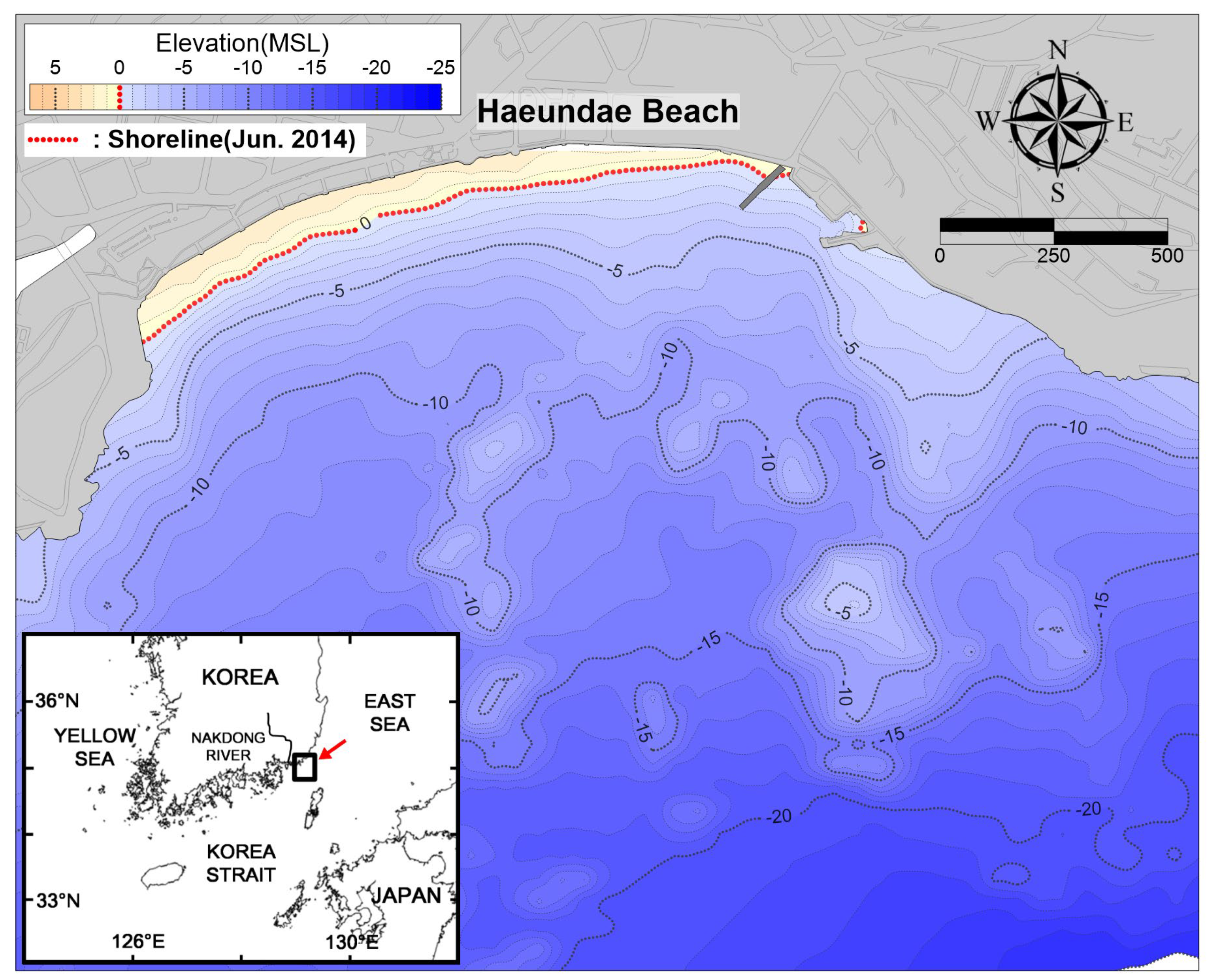
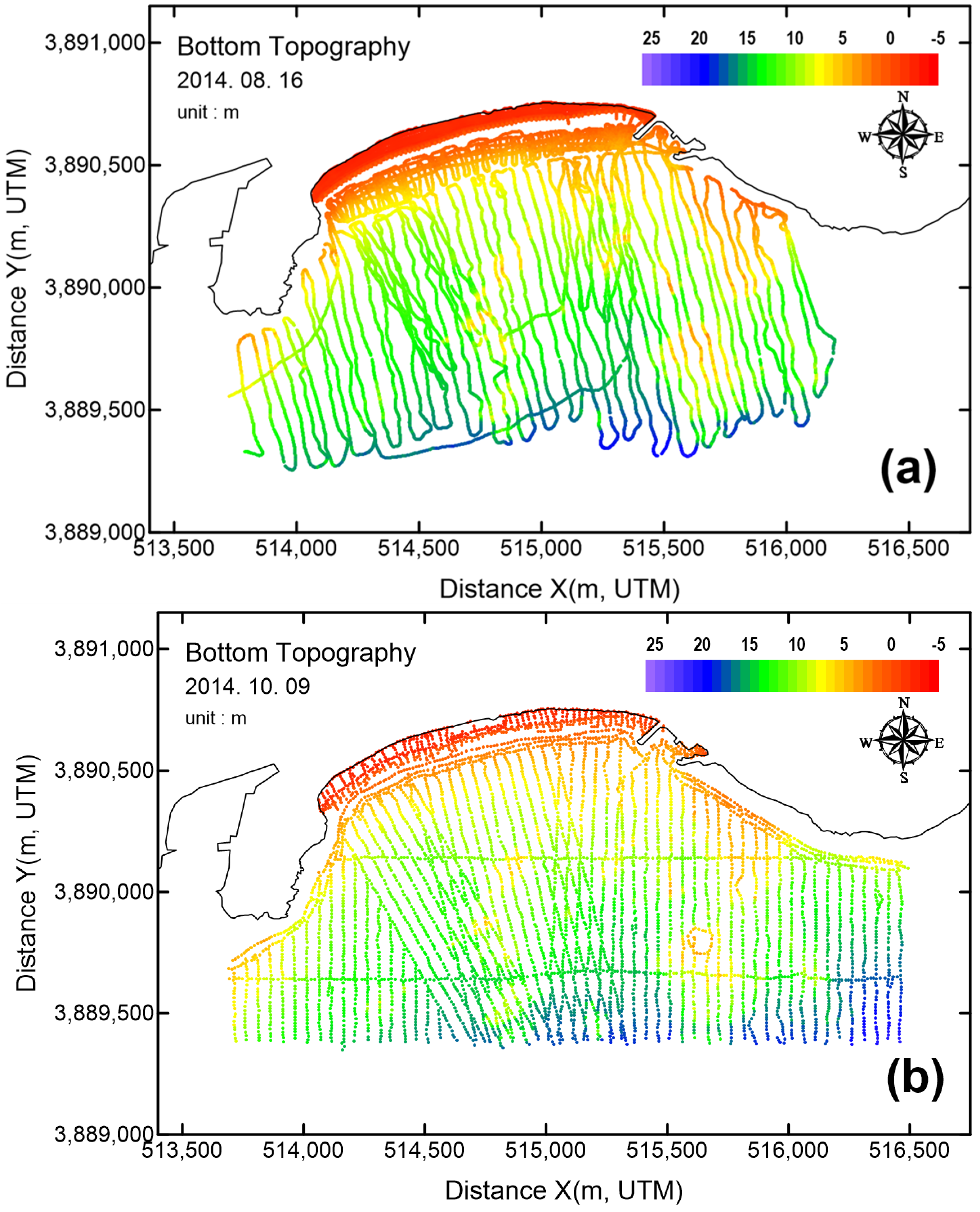
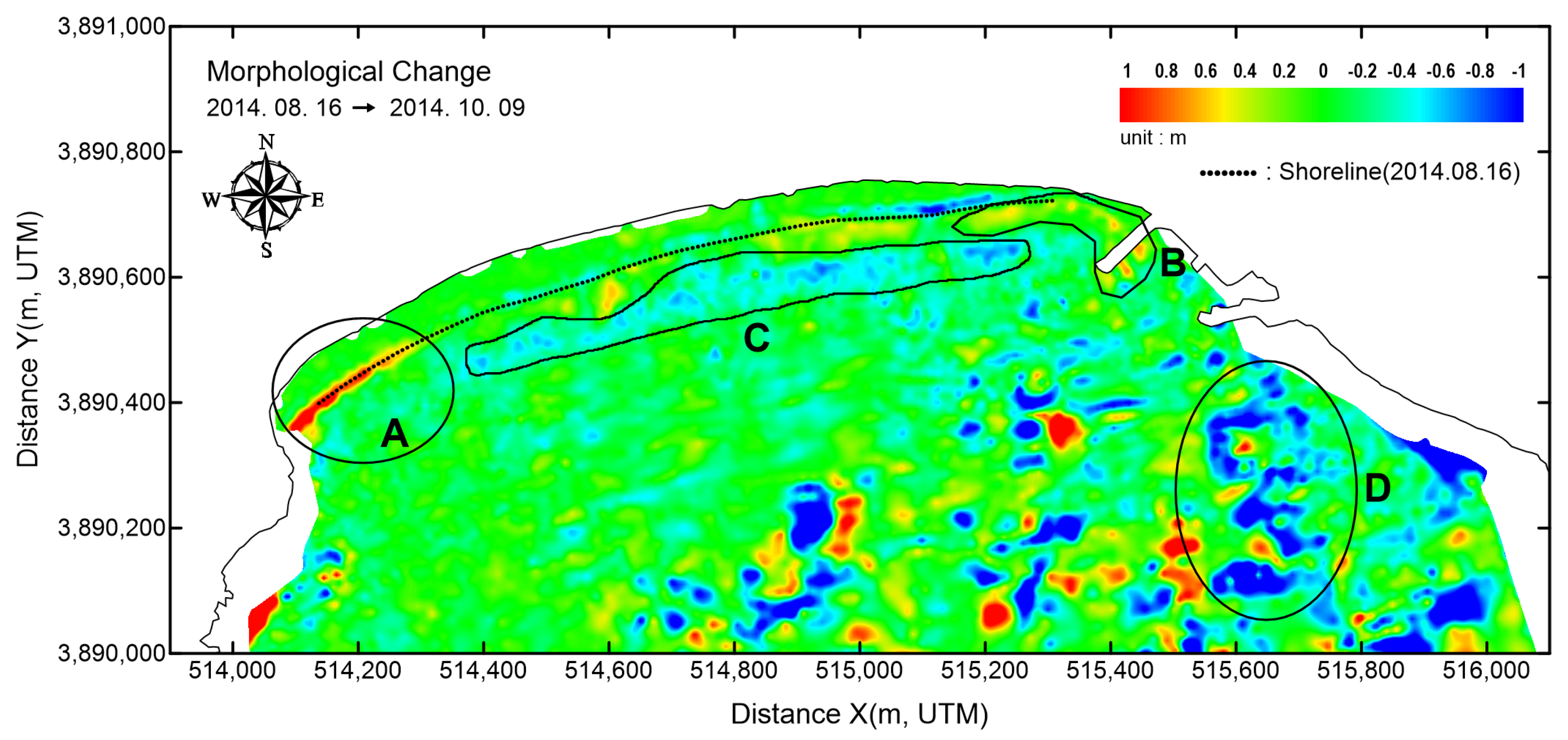
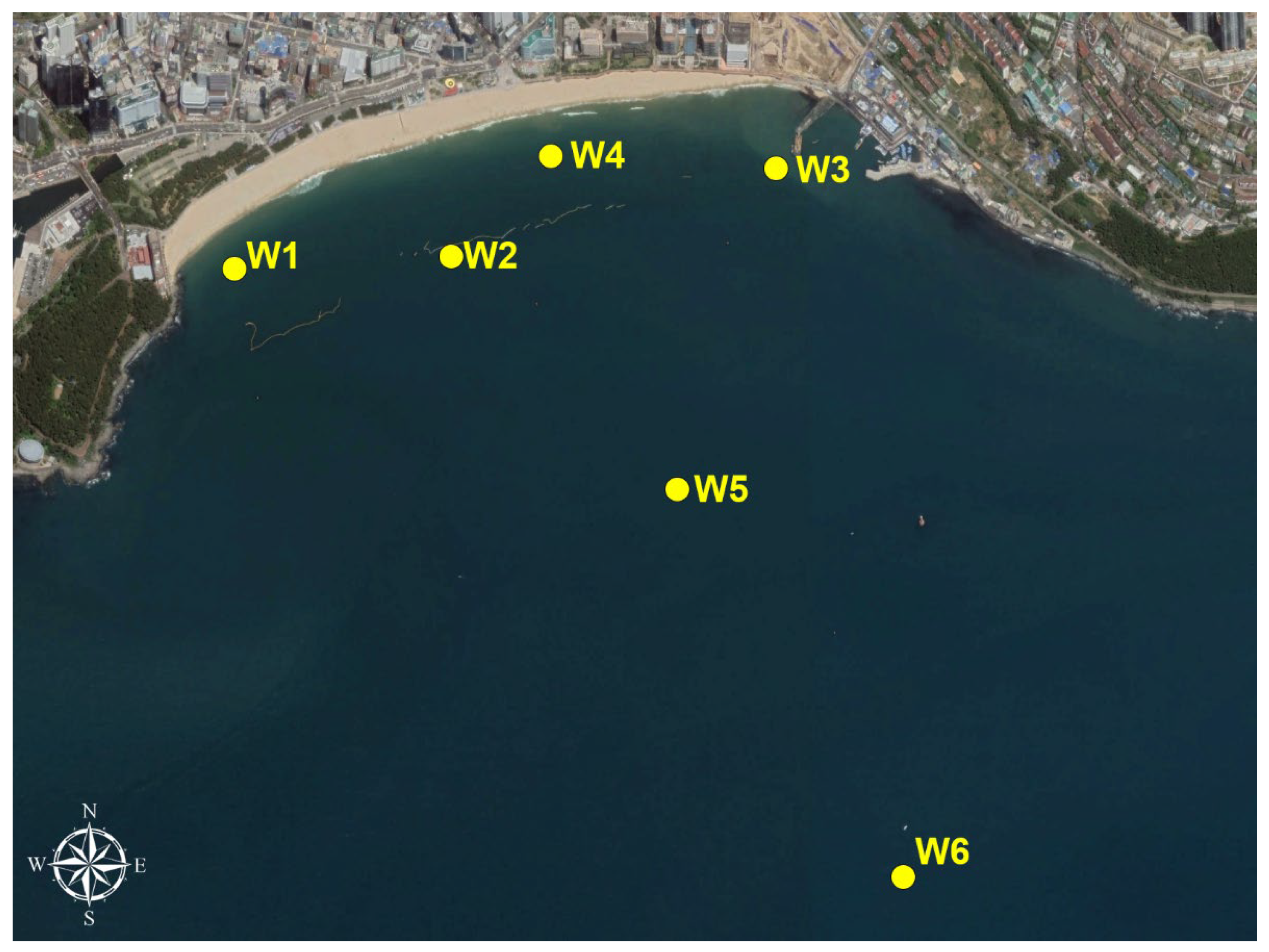
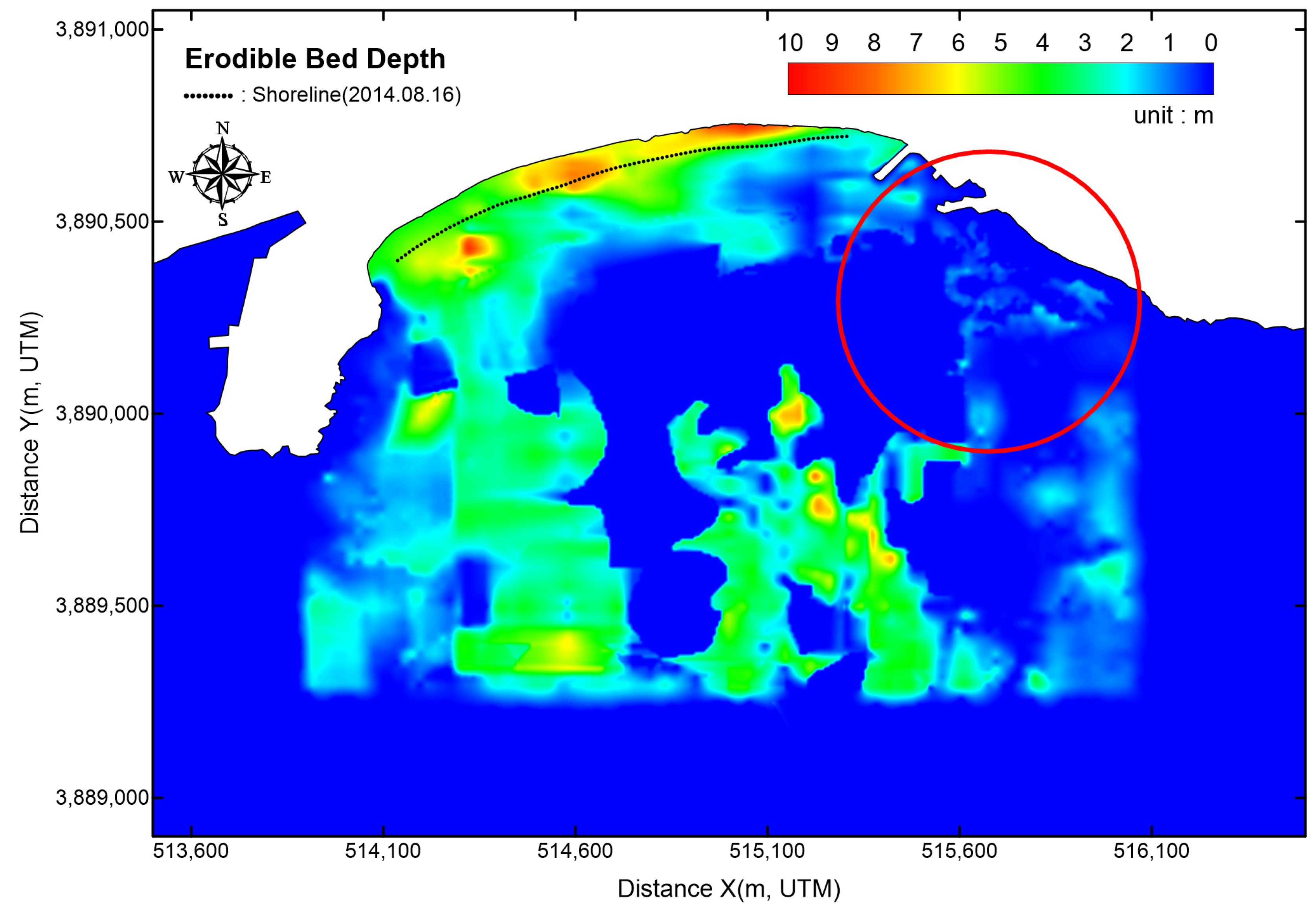
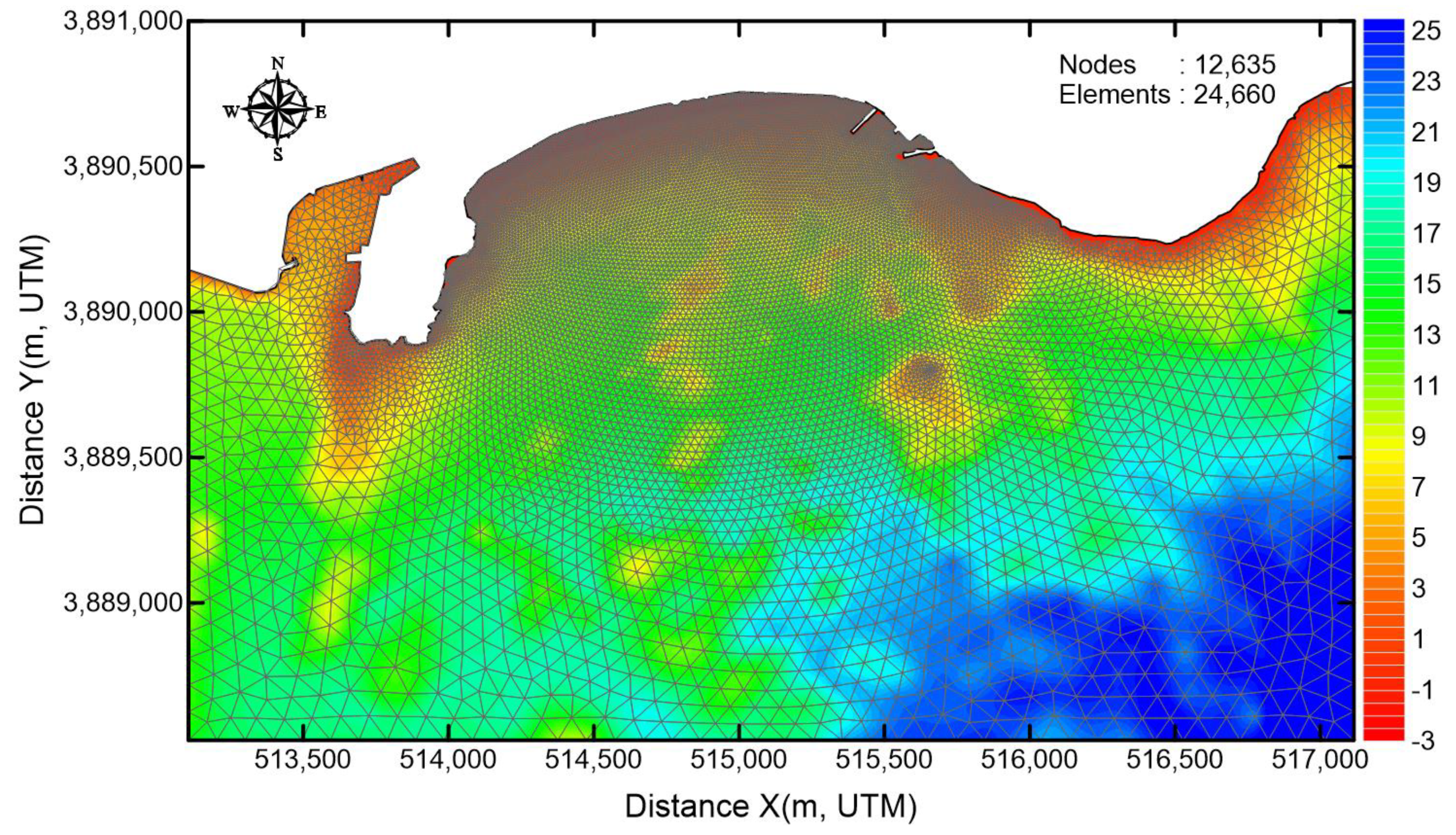
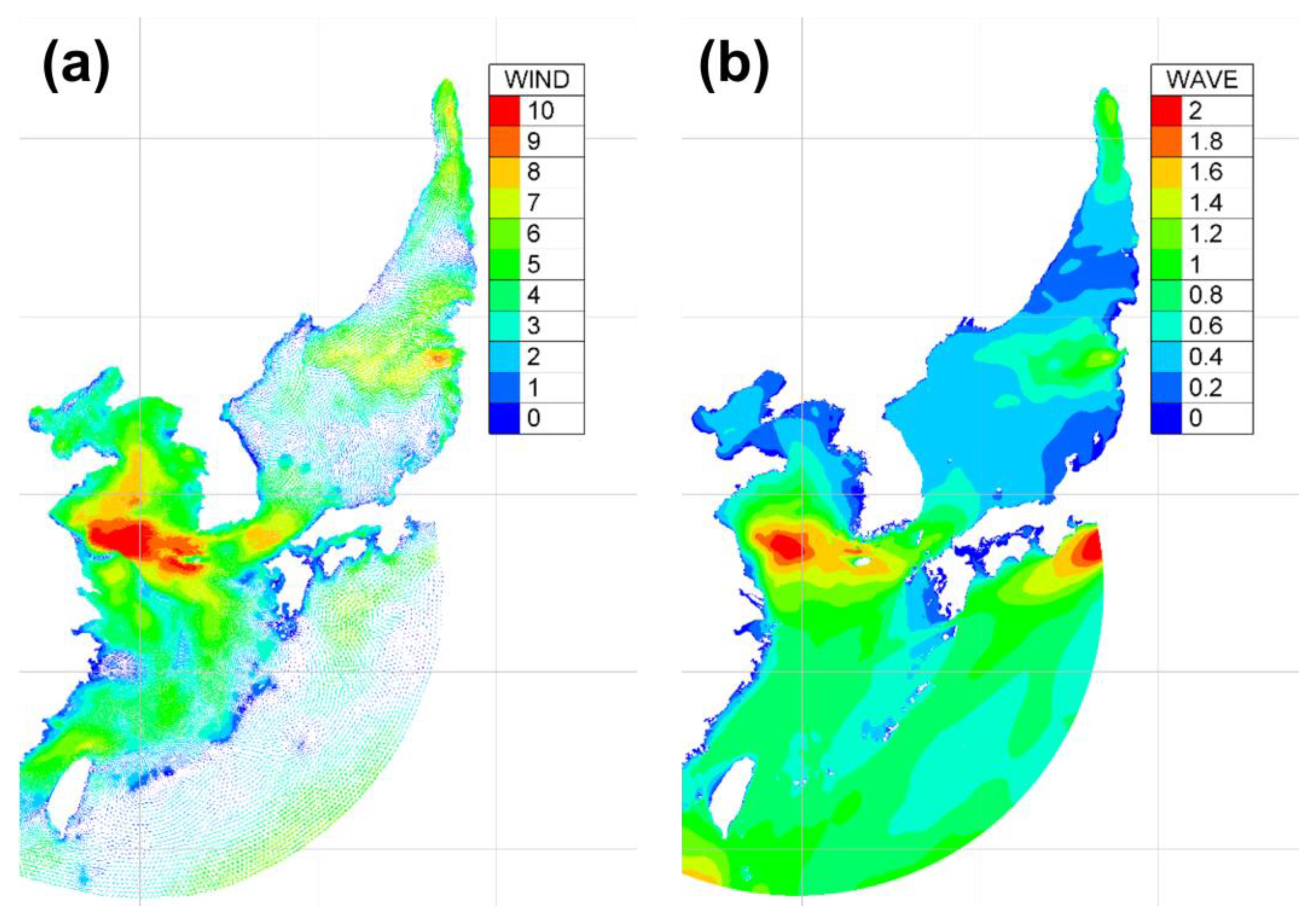
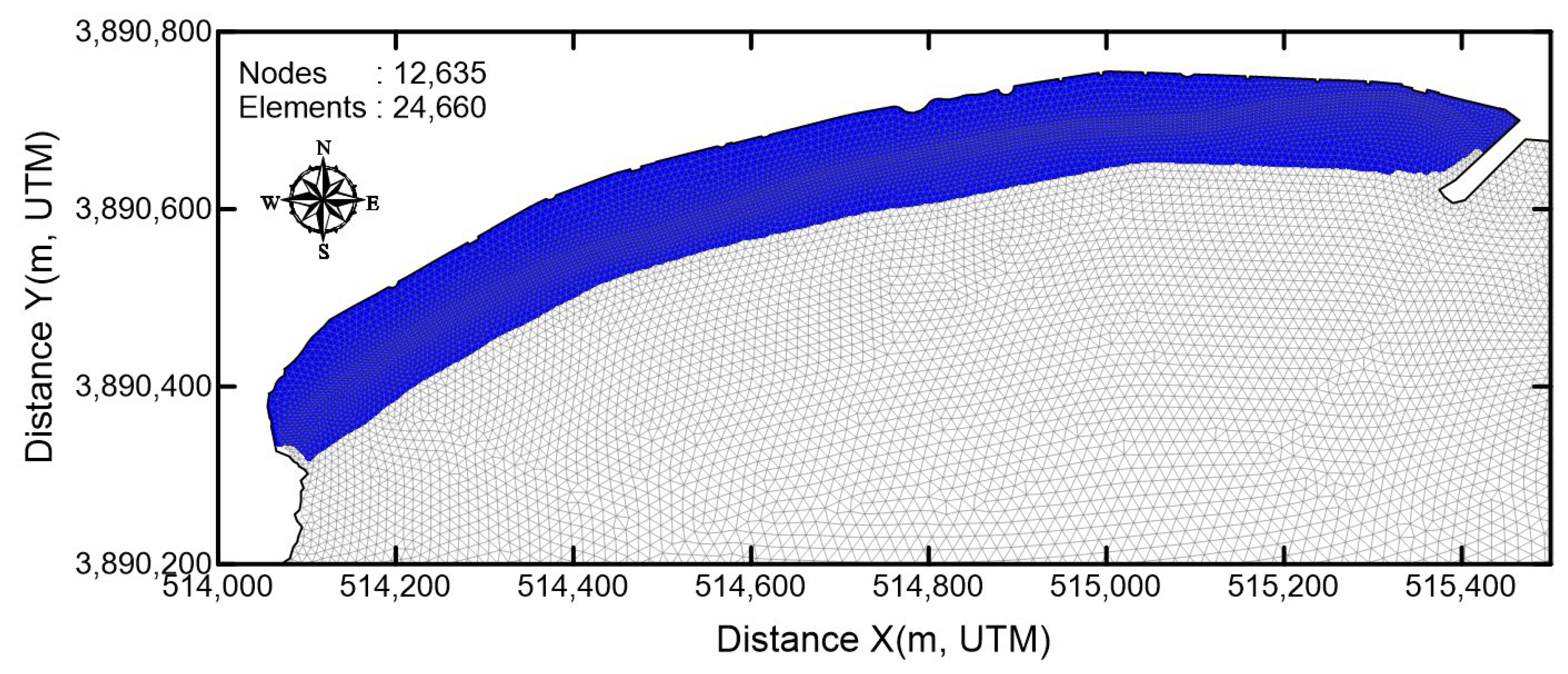
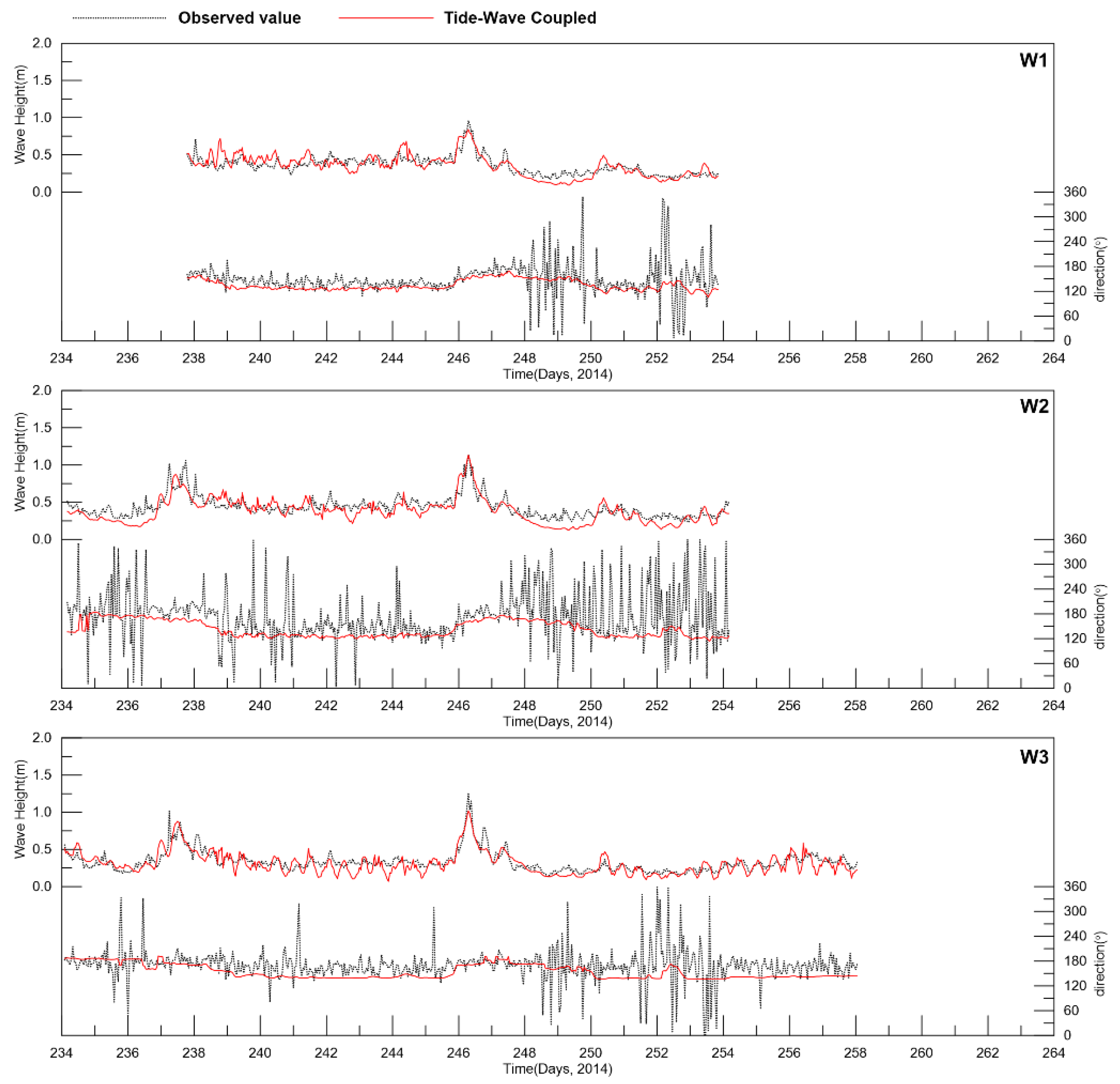
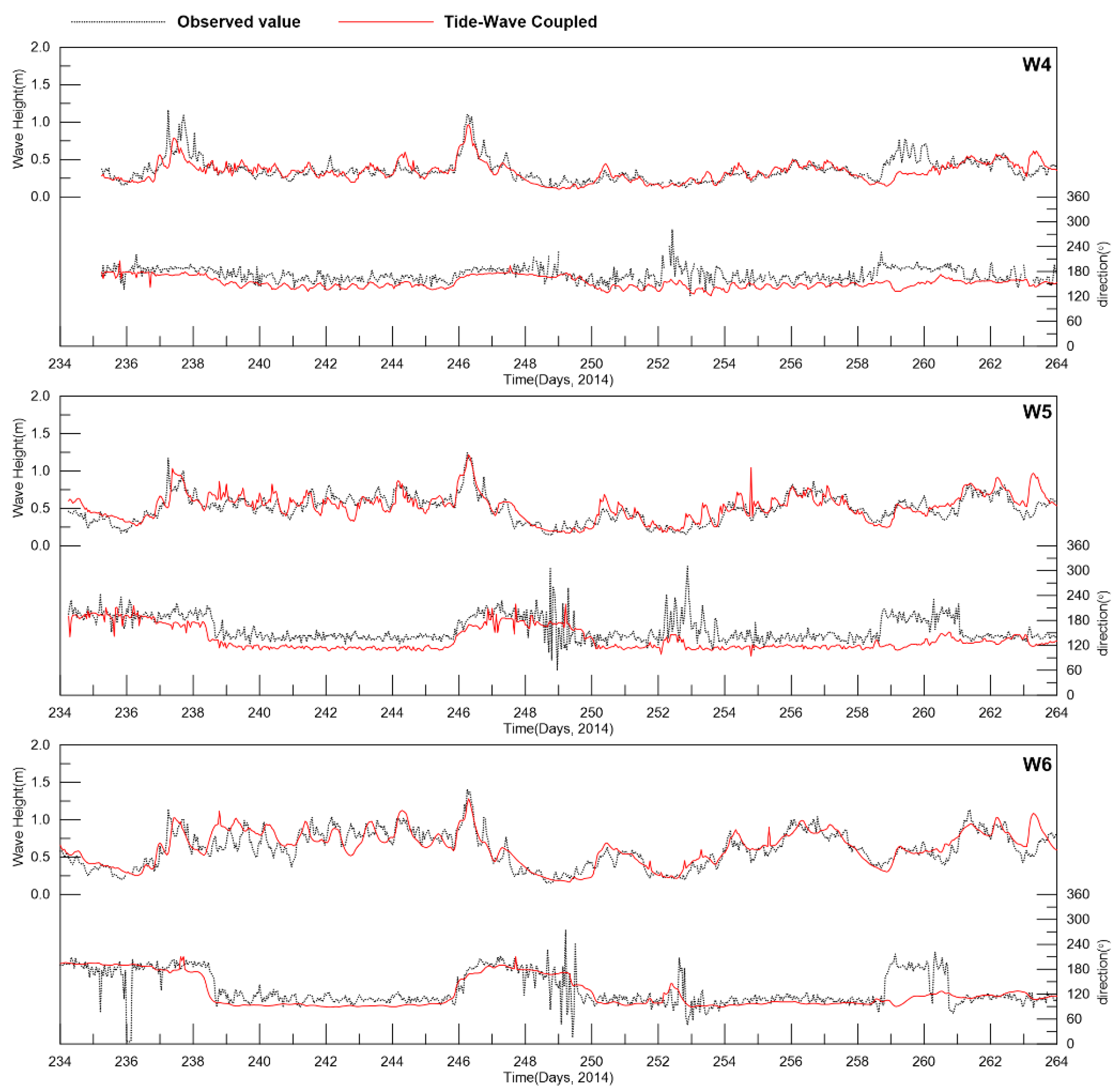
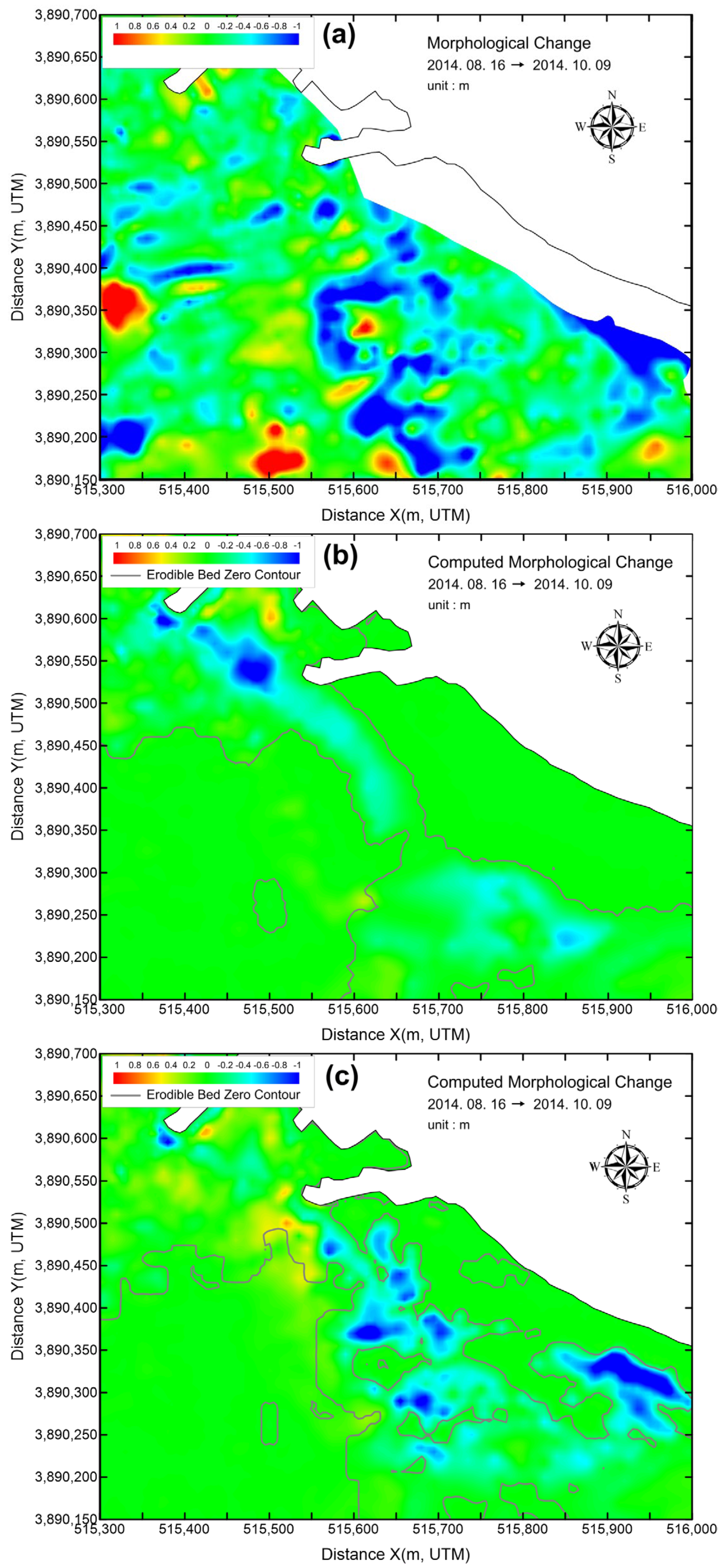

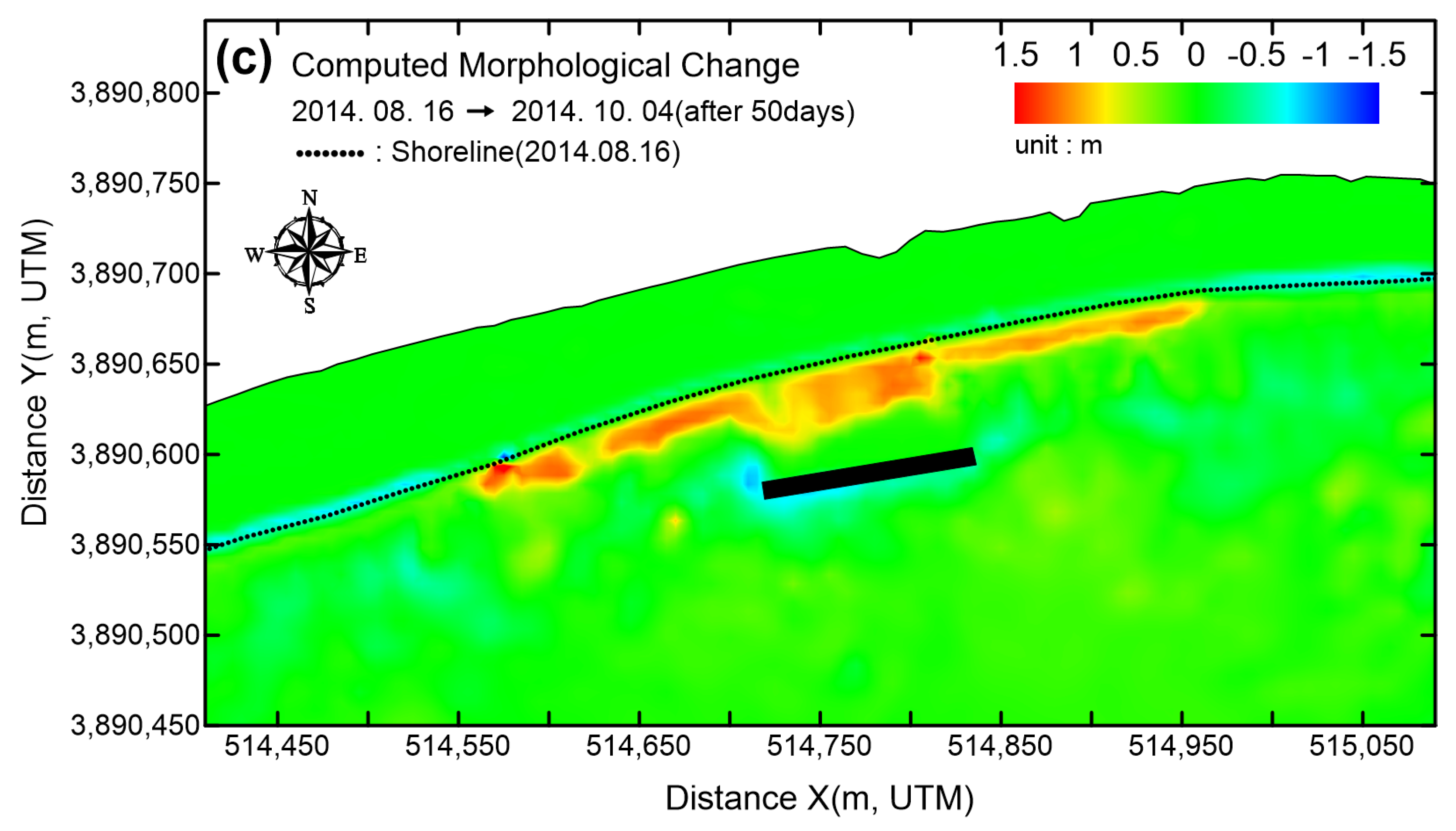

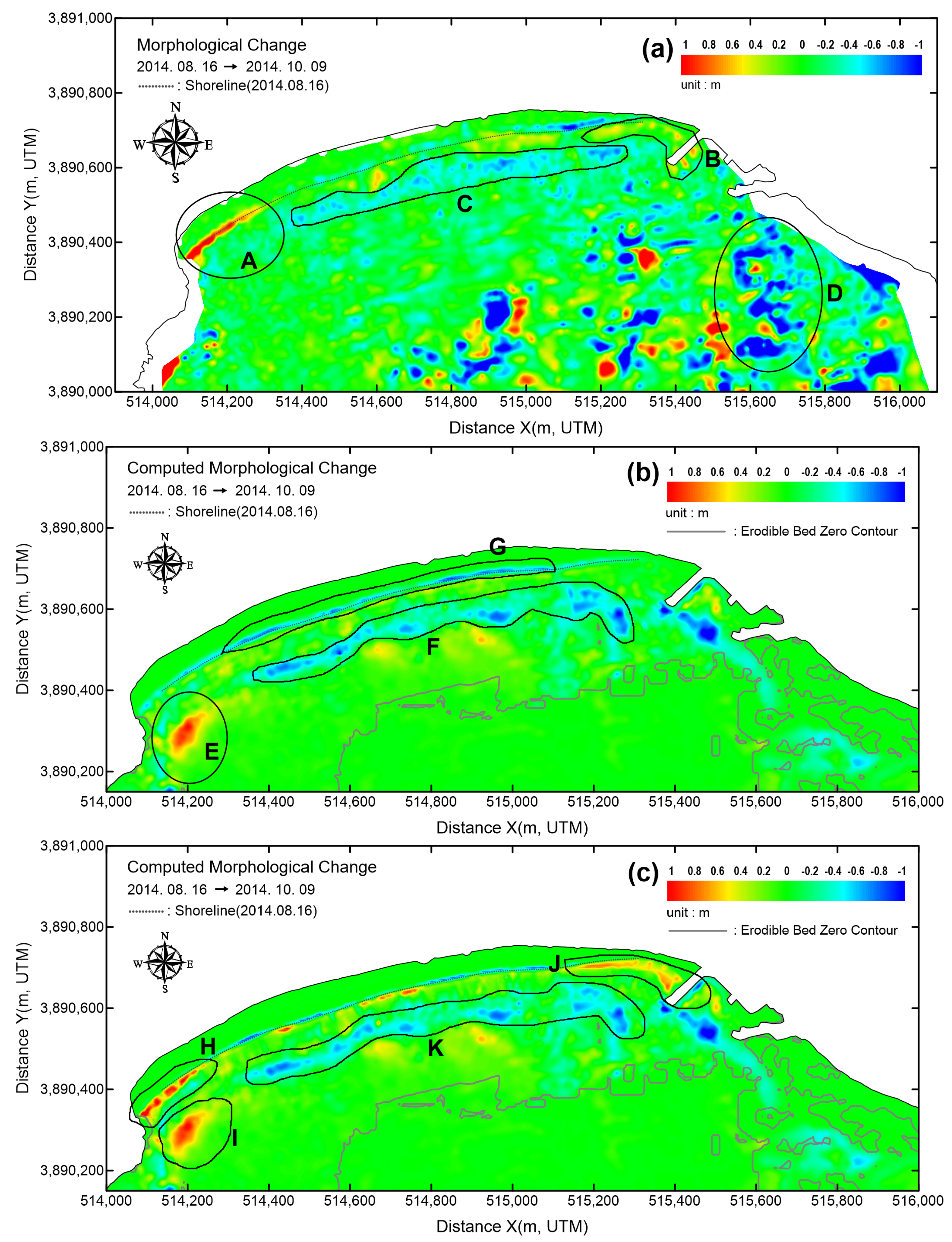
| Instruments | Observation Period | Burst Interval | Sampling Rate and Number of Samples Per Burst | |
|---|---|---|---|---|
| St. W1 | ADCP 1200 kHz | 16 days |
|
2 Hz and 2400
2 Hz and 1200 |
| St. W2 | ADCP 1200 kHz | 20 days | ||
| St. W3 | ADCP 1200 kHz | 24 days | ||
| St. W4 | AWAC 1000 kHz | 30 days | ||
| St. W5 | AWAC 500 kHz | 30 days | ||
| St. W6 | AWAC 500 kHz | 30 days |
| Section | (a) Observation (m3) | (b) without LW07 (m3) | (c) with LW07 (m3) |
|---|---|---|---|
| D | −16,910 | −13,936 | −13,514 |
| G | −4167 | −8489 | −5269 |
| H (A) | 4767 | −323 | 3372 |
| I (E) | 1135 | 5258 | 4962 |
| J (B) | 2344 | −12 | 3652 |
| K (C, F) | −8164 | −13,974 | −12,443 |
Disclaimer/Publisher’s Note: The statements, opinions and data contained in all publications are solely those of the individual author(s) and contributor(s) and not of MDPI and/or the editor(s). MDPI and/or the editor(s) disclaim responsibility for any injury to people or property resulting from any ideas, methods, instructions or products referred to in the content. |
© 2024 by the authors. Licensee MDPI, Basel, Switzerland. This article is an open access article distributed under the terms and conditions of the Creative Commons Attribution (CC BY) license (https://creativecommons.org/licenses/by/4.0/).
Share and Cite
Do, J.D.; Hyun, S.K.; Jin, J.-Y.; Jeong, W.-M.; Lee, B.; Chang, Y.S. Swash-Zone Formula Evaluation of Morphological Variation in Haeundae Beach, Korea. Water 2024, 16, 836. https://doi.org/10.3390/w16060836
Do JD, Hyun SK, Jin J-Y, Jeong W-M, Lee B, Chang YS. Swash-Zone Formula Evaluation of Morphological Variation in Haeundae Beach, Korea. Water. 2024; 16(6):836. https://doi.org/10.3390/w16060836
Chicago/Turabian StyleDo, Jong Dae, Sang Kwon Hyun, Jae-Youll Jin, Weon-Mu Jeong, Byunggil Lee, and Yeon S. Chang. 2024. "Swash-Zone Formula Evaluation of Morphological Variation in Haeundae Beach, Korea" Water 16, no. 6: 836. https://doi.org/10.3390/w16060836
APA StyleDo, J. D., Hyun, S. K., Jin, J.-Y., Jeong, W.-M., Lee, B., & Chang, Y. S. (2024). Swash-Zone Formula Evaluation of Morphological Variation in Haeundae Beach, Korea. Water, 16(6), 836. https://doi.org/10.3390/w16060836








